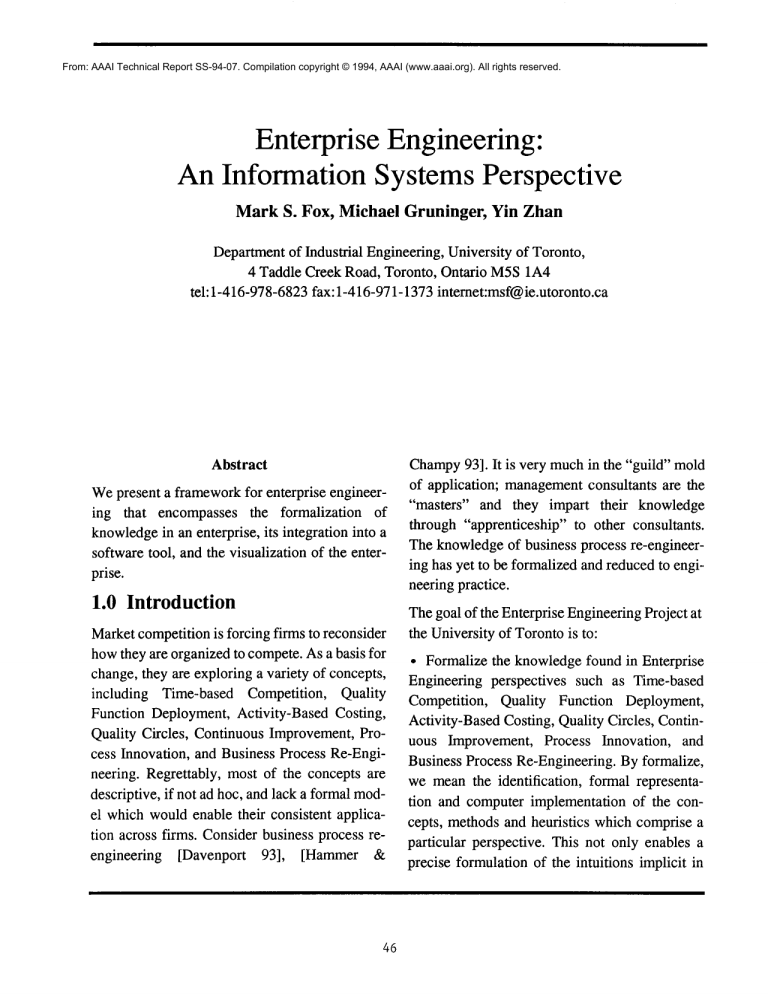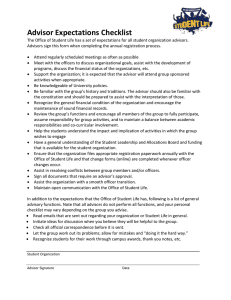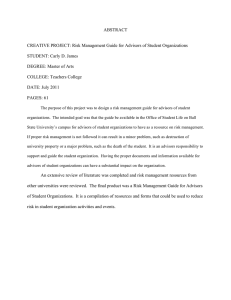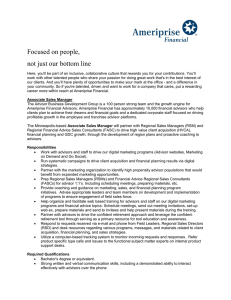
From: AAAI Technical Report SS-94-07. Compilation copyright © 1994, AAAI (www.aaai.org). All rights reserved.
Enterprise Engineering:
An Information Systems Perspective
MarkS. Fox, Michael Gruninger, Yin Zhan
Departmentof Industrial Engineering, University of Toronto,
4 Taddle Creek Road, Toronto, Ontario M5S1A4
tel: 1-416-978-6823fax: 1-416-971-1373intemet:msf@ie.utoronto.ca
Abstract
Wepresent a frameworkfor enterprise engineering that encompasses the formalization of
knowledgein an enterprise, its integration into a
software tool, and the visualization of the enterprise.
1.0 Introduction
Marketcompetitionis forcing firms to reconsider
howthey are organized to compete.As a basis for
change, they are exploring a variety of concepts,
including Time-based Competition, Quality
Function Deployment, Activity-Based Costing,
Quality Circles, Continuous Improvement,Process Innovation, and Business Process Re-Engineering. Regrettably, most of the concepts are
descriptive, if not ad hoc, and lack a formal model which wouldenable their consistent application across firms. Consider business process reengineering
[Davenport 93], [Hammer &
46
Champy93]. It is very muchin the "guild" mold
of application; managementconsultants are the
"masters" and they impart their knowledge
through "apprenticeship" to other consultants.
The knowledgeof business process re-engineering has yet to be formalized and reducedto engineering practice.
Thegoal of the Enterprise EngineeringProject at
the University of Torontois to:
¯ Formalize the knowledgefound in Enterprise
Engineering perspectives such as Time-based
Competition, Quality Function Deployment,
Activity-BasedCosting, Quality Circles, Continuous Improvement, Process Innovation, and
Business Process Re-Engineering. By formalize,
we meanthe identification, formal representation and computer implementation of the concepts, methodsand heuristics which comprise a
particular perspective. This not only enables a
precise formulation of the intuitions implicit in
practice, but it is also a step towards automating
the execution of certain tasks involved in enterprise engineering
° Integrate the knowledgeinto a software tool
that will support the enterprise engineering function by exploring alternative organization models
spanning organization structure and behaviour.
The Enterprise Engineering system allows for the
exploration of a variety of enterprise designs. The
process of exploration is one of design, analysis
and re-design, where the system not only provides
a comparativeanalysis of enterprise design alternatives, but can also provide guidance to the
designer.
¯ Provide a meansfor visualizing the enterprise
from manyof the perspectives mentionedabove.
The process of design is performedthrough the
creation, analysis and modificationof the enterprise from within each of the perspective visualizations.
In the remainderof the paper wefirst provide an
overviewto the Enterprise Engineeringsystem architecture. Wethen describe each componentin
detail. Lastly, wedescribe the status of our implementation.
Variousperspectives exist in an enterprise, such as
efficiency, quality, and cost. Anysystemfor enterprise engineering must be capable of representing
and managing these different perspectives in a
well-defined way. These ideas are formalized in
the notion of advisors that are able to analyze,
guide, and makedecisions about the current enterprise and possible alternatives.
In addition to representing the knowledgein an
enterprise, it is useful to be able to visualize the
different perspectives that we have in the enterprise. This requires the existence of an environment which can graphically represent the advisors
in the system and the interactions amongthese
advisors, including workflowmonitoring and execution.
Lastly, there is an execution environmentwhere
the portions of the enterprise design maybe, i.e.,
those portions that define databases and machine
executable activities, down-loadedfor execution
by the run-time system.
3.0 Common
Sense Enterprise
Modelling
Enterprise modelling is an essential componentin
defining an enterprise.The goal of our enterprise
2.0 Architecture for Enterprise
modellingresearch is to create a generic, reusable
Engineering
representations of Enterprise Knowledgethat can
be reused across a variety of enterprises. Towards
The Enterprise Engineering system is composedof
this end, we have been developing the TOVE
enterfour main components: its common-senseenterprise model, advisors, visualization, and informa- prise ontology[Fox et al 93]. Anontologyis a formaldescription of entities and their properties; it
tion agents.
formsa shared terminologyfor the objects of interThe foundation for the system is the common- est in the domain, along with definitions for the
sense enterprise model.It provides a set of generic meaning of each of the terms. TOVEprovides a
reusable representations of enterprise knowledge. rich and precise representation of generic knowlThis includes representations for processes, activiedge, such as, activities, processes, resources, time,
ties, time, causality, resources, quality, and cost.
and causality, and of more enterprise oriented
The enterprise model is used by all other compo- knowledgesuch as cost, quality and organization
nents of the system by providing a shared termistructure.
nologyand set of constraints.
47
Thebasic entities in our modelare represented as
objects with specific properties and relations. Objects are structured into taxonomies.Definitions of
objects, attributes and relations are specified in
first-order logic, wherepossible. Wethen define an
ontologyin the followingway. Wefirst identify the
objects in our domainof discourse; these will be
represented by constants and variables in our language. Wethen identify the properties of these objects and the relations that exist over these objects;
these will be represented by predicates in our language.
Wenext define a set of axiomsin first-order logic
to represent the constraints over the objects and
predicates in the ontology. This set of axiomsconstitutes a microtheory ([Lenat & Guha90]) and
provides a declarative specification for the various
tasks we wish to model.
Intuitively, the axiomsin the microtheory enable
the modelto deduce answers to questions that one
would normally assume can be answered if one
has a "common-sense"understanding of the enterprise. To formalize this intuition we also need to
prove results about the properties of our microtheories in order to providea characterization and justification for our approach; this enables us to
understand the scope and limitations of the
approach. Weuse a set of problems, whichwe call
competencyquestions, that serve to characterize
the various ontologies and microtheories in our
enterprise model. The microtheories must contain
a necessary and sufficient set of axiomsto represent and solve these questions. It is in this sense
that we can claim to have an adequate microtheory
appropriate for a given task, and it is this rigour
that is lacking in previous approachesto enterprise
engineering.
The following ontologies have been designed as
part of the Enterprise EngineeringProject at the
University of Toronto:
48
¯ Activities and States: Theformalization of the
notion of process and activity is crucial in any
attempt at business process re-engineering. Activities are the basic events that specify a transformation on the world [Fox et al. 93]. States specify
what must be true for an activity to be performed,
and what is true oncethe activity is completed.
¯ Time:Activities are initiated at points in time,
and once initiated, they have duration over some
interval of time. Further, properties of states hold
over the duration of these activities. To represent
these intuitions, weextend the temporal relations
in [Allen 83].
¯ Resources: All activities require that some
objects be available at the time that the activity is
performed; this is the motivation for a theory of
resources. Thevarious properties that are axiomatized in the microtheory include the distinction
between reusable vs. consumable resources,
resource commitment, and the availability
of
resources [Fadel & Fox 93].
¯ Quality: The work in this domainis concerned
with creating a terminologythat spans quality concepts found in ISO9000, Baldridge Award, etc.
[Kim & Fox 93].
¯ Cost: The goal is to formalize the concepts
foundin activity-based costing.
4.0 Advisors
The best enterprise design is one that optimises
eachof the perspectivesthat exist in the enterprise.
Examples of enterprise perspectives include:
Quality, Cost, Efficiency, Agility, and Incentives.
Weare developing for each perspective a theory of
design that results in the optimization of the perspective. The theory incorporates the ability to
measurea partial/complete design and to guide the
designer in the decision making. One issue is
whether there exists sufficient knowledgeof the
process of designing and optimizing business
activities/processes to incorporate in knowledgebased tools.
ties from being performed concurrently and thus
anticipate resource conflicts that lead to bottlenecks.
To formalize the intuition of design perspectives,
weintroduce the notion of advisors. Anadvisor is
an encapsulation of one or moremicro-theories. It
has the ability to analyse, guide and makedesign
decisions. Weare currently constructing advisors
for Efficiency, Activity-based Costing, Resource
Management, and ISO9000; we anticipate advisors for goals and objectives, organization structure, incentives, and culture. In each case, weare
defining the tasks, purpose, and responsibilities of
the advisor, and represent these tasks using the
appropriate ontology. As with the competency
questions in the preceding section, each advisor is
rigorously characterized by these tasks. This
includes specifying what an advisor is analyzing
and in what waythat they guide (propose different
alternatives).
Nowconsider the notion of a ISO9000 advisor,
which uses a microtheory of ISO 9003 compliance
[Kim & Fox 93]. This microtheory introduces axioms to represent the ISO 9003 requirements and
axioms defining howan organization can be ISO
9003 compliant. The primary decision-making
capability of the quality advisor is therefore determining whether an organization is ISO 9003 compliant.
Consider the efficiency advisor. The modelling
task provides ontologies that can be used to construct a modelof the activities of a process, temporal relations over these activities, and constraints
on the usage of resources by the activities. Based
on these models the efficiency advisor provides
tools to design, analyzeand evaluate the enterprise
from the perspective of optimising efficiency. For
example,it can performa critical path analysis of
an activity graph or process, or it maysimulate a
process if more complexactivity behaviours are
involved.
The advisor must be able to represent and model
the current status of the process and assess potential changes. This is essential if the advisor is
required to guide the designer by presenting alternatives. For example, we mayneed to knowif a
process would be moreefficient given one ordering of activities rather than another. This may
entail identifying the resources that preventactivi-
49
The ISO 9003 requirements can be divided into
those that can be met by just one process (locally
compliant requirements) and those that require
several or all processes of an enterprise (globally
compliant requirements). For example, to satisfy
ISO 9003 local compliance, there must exist processes that performproduct identification, inspection and testing, identify test status, control
nonconformity, and arrange for handling of products; this is an axiomin the microtheory.Anadvisor can use this axiomin several different ways. It
can be used to analyze a process within the enterprise and decide compliance by verifying the
existence of the necessaryprocesses. It can also be
used by a designer by recommendingthe appropriate quality control processes that must be included
in order to satisfy local compliance.
5.0 Enterprise Visualization
The "state-of-the-art" of enterprise engineering
visualizations is to fill the four walls of a room
with pieces of paper detailing the organization
structure and the activities within organizational
units. Colouredstring is usedto tie together activities that comprisea process that spans two or more
organizational units. The reason whythe "four
wall" method is preferred is simply the sheer
amount of information that has to be "seen" at
once and the ease with which it can be modified.
Existing design tools, such as Digital’s DEC-
Model and Kralman’s MAGIC,can only provide
small samplesof processes and organization structures, hence limiting the user’s ability to understand the entirety of the process. In order for
computers to play a broader role in enterprise
engineering, morecreative methodsof visualizing
enterprises are required. In this section weraise
several issues centred around the problem of
designing the appropriate visual environmentfor
enterprise engineering, and the role that microtheories and advisors play in any such environment.
Supporting the different levels of description
within an enterprise requires appropriate abstraction and elaboration constructs in the underlying
knowledge-basedsystem. Aspects of the visualization can also be derived from the ontologies and
microtheories of the advisors. The competency
questions for these microtheories characterize the
necessary properties that they must be able to represent, and it is these properties that are essential
for any understanding of the task. Hencethese are
the important properties that must be displayed in
any visualization of the enterprise.
To present the visualization, we mayorganize the
domainknowledgeof each individual advisor into
a workbench, and provide different viewing projections of a given domain,as well as allow different levels of visualization of a given projection.
Oneobjective is the developmentof a symbology
that depicts terms and concepts of the underlying
knowledge-based system in a graphical context.
The symbology should be precise and general
enough to support visual programingfor performing the modelling task. These issues are relevant
for the efficiency and cost advisors, where the
major issue is finding the best visual representation for their tasks and microtheories. Theyare of
particular importance for the moreabstract advisors such as goals, objectives, incentives, and culture.
5O
Workflow monitoring and execution are also
closely related to the visualization of the enterprise. Theproblemin this case is to create an adequate representation for the enterprise as it evolves
in time, which is captured in the notion of the
ontologies for activities, resources, and time. For
example, one output of enterprise design is the
definition of a graph of activities in which subgraphs of activities define critical enterprise processes. Minimally, we should be able to use the
graph to support the monitoring of process performance. Maximally, some of these activities may
be executable directly by the system.
This maygive the impression that the advisors are
independent of each other; this is not the case.
Each of the microtheories implemented in the
advisors is closely related to the other microtheories, and this leads to a close interdependency
amongthe different perspectives. The status of
activities is dependent on the times at which its
resources are available; in turn, the cost is dependent on the status of an activity, such as whenit is
executing and whenit has been suspended. All of
these relationships provide different perspectives
on the processes in an enterprise, as captured in
the advisors; however, existing graphical interfaces fail to capture the dimensionality of these
interdependencies.
The relationship amongthe various advisors also
leads to the possibility of mergingvisualizations.
Howdo we represent the interaction between cost
and the temporal structure of activities in a process? Whatrole do resource usage constraints play
in the quality of a product, and howis this best
visualized? Ideally, we should be able to combine
the visualizations of each advisor in a way that
highlights these interactions.
In the previous section we saw how one of the
tasks of the advisors is guiding the designer by
representing alternative futures and possibilities
for the processes in an enterprise. Althoughthis is
done formally by the microtheories of the advisors, there is a need for an adequate visual environment for guiding this kind of hypothetical
reasoning.
An additional requirement that arises from this
architecture is that an Enterprise Engineeringenvironmentmust support workgroups- different people will be workingon or with the sameenterprise
model and the system has to coordinate these
activities. Thisalso includes the ability to support
concurrent modelling processes and to coordinate
and monitorthe contributions and activities of different people that are involved in these tasks. In
turn, this requires the negotiation of inconsistent
changes to the model.
7.0 Current Status
Wehave developed ontologies for: activities and
states, time, resources, quality, and cost. Advisors
and their corresponding microtheories are under
development for resource management,activitybased costing and ISO9000quality compliance. A
"virtual factory", called TOVE,has been defined
using the ontology, and serves as a testbed for research into enterprise integration. It is implemented
in C++ using the ROCK
knowledgerepresentation
tool from Carnegie Group. The axiomsin the various microtheories are implementedusing Quintus
Prolog which is integrated with the knowledgebase
in ROCK.
Wehave also developed a distributed simulation
environment called TOVESim
which oversees the
execution of events and maintains time across multiple agents spread across the internet. Weare currently working on extending the ontologies,
advisors and the ideas for enterprise visualization
discussed in this paper.
6.0 Enterprise Implementation
Enterprise execution focuses on the implementation of an enterprise design. In particular, it is concerned with both monitoring the performance of
enterprise as specified by the model, and executing tasks that can be automated. Our execution
model is based on the Enterprise Management 8.0 Conclusions
Network [Roboam& Fox 92], and is called the
Enterprise Information Architecture (EIA). The In this paper, wehave defined an architecture for
an enterprise engineering system that allows the
execution environment is composedof a set of
functional and information agents, each of which exploration of a variety of enterprise designs. This
workhas raised several important issues. First, it
performs continuously and autonomously. Functional agents performactivities, and information has proposed that the knowledgeimplicit in engineering practice must be formally represented and
agents managethe distribution and consistency of
characterized through ontologies and microtheoinformation.
ries. This formalization provides the foundation
Given an enterprise design, we should be able to
for the other componentsof the system.
deduce what the organization structure of the
enterprise information system should be, the func- In order to integrate this knowledgeinto a softtional agents and their assigned activities, and how ware tool that will support enterprise engineering
information is to be distributed and maintained functions, we introduced the notion of an advisor
as a formalizationof the different perspectives that
across the network in order to support the funcwehave with respect to an enterprise.
tional agents. Thus as more and more work
becomes automated, the linkage between design
Thevisualization of an enterprise requires a graphand execution increases in importance.
ical interface that represents the abilities and perspectives of the various advisors as formalized in
the advisors’ microtheories.
51
Finally, an importantapplication of the representation of knowledgein ontologies and microtheories
is that it enables us to automatethe execution of
certain enterprise engineering tasks. This also
allows us to represent workflow monitoring and
execution within the sameframework.
9.0 References
[Allen 83] Allen, J.F. Maintaining Knowledge
about TemporalIntervals. Communicationsof the
ACM.26:832-843, 1983.
[Davenport 93] Davenport, T.H. Process Innovation: Reengineering Workthrough Information
Technology. Harvard Business School Press, 1993.
[Fadel & Fox 93] Fadel, F. and Fox, M.S. A
Resource Ontology for Enterprise Modelling (submitted).
[Foxet al. 93] Fox, M.S., Chionglo,J., Fadel, F. A
Common-Sense
Model of the Enterprise, Proceedings of the Industrial EngineeringResearchConference 1993.
[Kim & Fox 93] Kim, H. and Fox, M.S. Quality
Systems Modelling: A Prospective for Enterprise
Integration, Fourth AnnualMeeting of the Production and Operations ManagementSociety. 1993.
[Hammer & Champy93] Hammer, M. and
ChampyJ. Reengineering the Corporation. Harper
Business, 1993.
[Lenat & Guha90] Lenat, D. and Guha, R.V.
Building Large Knowledge-basedSystems: Representation and Inference in the CYCProject. Addison Wesley, 1990.
[Roboam& Fox 92] Roboam,M. and Fox, M.S.
Enterprise ManagementNetwork Architecture,
Artificial Intelligence Applications in Manufacturing. AAAIPress / MITPress, 1992.
52



